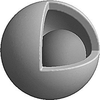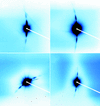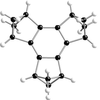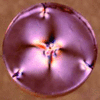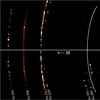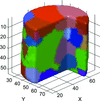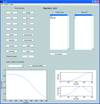issue contents
December 2013 issue

Cover illustration: A schematic of a new X-ray scattering geometry, grazing-incidence transmission small-angle X-ray scattering. The incident beam impinges on the edge of a nanostructured surface at a grazing angle, and exits through the sample's edge. The method is demonstrated for gratings where it is shown that the Born approximation is valid with a simple and small correction. Courtesy of Lu et al. [J. Appl. Cryst. (2013), 46, 165-172].
research papers
A novel capillary-based micro-battery cell for in situ X-ray powder diffraction has been developed and used to study the initial intercalation and deintercalation of lithium into graphite in a working battery.
V-shaped channel-cut monochromators were employed for an extreme X-ray beam compression in a laboratory setup for grazing-incidence small-angle X-ray scattering (GISAXS). Compressor advantages in terms of the output X-ray beam parameters and a compact GISAXS setup design are demonstrated by a comparison with traditional collimation schemes.
A theoretical model of the coherent scattering cross section of yolk–shell particles is presented.
An increase in the damage cross section of swift heavy-ion tracks in apatite and quartz with increasing formation temperature has been observed and explained using small-angle X-ray scattering and molecular dynamics simulations.
Following a homogeneous nucleation catastrophe from an unstable Y–Ba–Cu–O solution, ultra-low supersaturation was realized, which was successfully applied to grow pure a-axis YBa2Cu3Oy liquid-phase epitaxy films on (110) NdGaO3 substrates.
The element specificity and contrast variation properties of the resonance effect are utilized to combine structural with chemical analysis of thin films. The composition profile of a multi-element low-contrast (<0.6%) thin-film system is determined from the free surface to buried interfaces within a few atomic percentages of precision and with depth resolution at the nanometre scale.
The reflectivity in Laue geometry of crystals bent by surface damage has been measured at 17, 59 and 120 keV X-ray energy. Despite the presence of a damaged zone several tens of micrometres deep, the crystals behave as self-standing bent nearly perfect crystals and are proposed as optical elements for focusing hard X-ray beams.
The structure factor of liquid Bi is determined to high accuracy and serves as a model system to explore determination of radial distribution functions from experimental data. A physically motivated asymptotic approach to extending the measured structure factor to large wavevectors is introduced. This method leads to smooth radial distribution functions and is shown to be both simple to apply and robust.
A new tangent procedure is designed to increase phasing efficiency in ab initio procedures. Algorithms and applications are described.
Hopper-like Cu2O cubes were crystallized in alkaline citrate–copper solution by controlling the equilibrium between complexation, precipitation and redox reactions. This work opens a predictive way to rational crystallization of oxide micro/nanocrystals and links chemical reactions with the crystallization process, because OH− ions are always involved in these chemical reactions.
A high-precision spin-coater system has been designed, implemented and used to investigate the formation process and film thickness of a triblock copolymer using grazing-incidence small-angle X-ray scattering (GISAXS) with high temporal resolution.
A quantitative method for analyzing diffuse scattering through evolutionary algorithms is described using the faulted layer stacking compound tris(bicylco[2.1.1]hexeno)benzene as an example. The wall clock time for computing large simulated crystal volumes is kept to reasonable limits through the parallel calculation of many crystals (clones).
Open  access
access
 access
accessA new powder diffractometer operating in transmission mode is described. It can work as a rapid very compact instrument or as a high-resolution instrument, and the sample preparation is simplified.
The effect of seed rotation on crystal/melt interface shapes (convex/flat/concave) and the resulting effect on optical homogeneity have been investigated on Nd-doped gadolinium gallium garnet (GGG) laser crystals. This investigation also led to optimization of the best crystal growth conditions (seed rotation) to obtain an optically homogeneous crystal, with a marked correlation between optical homogeneity, crystalline perfection and crystal/melt interface shape governed by the seed rotation.
Pure thin tin films, electroplated on copper substrates, were investigated by in situ X-ray diffraction analysis during room-temperature aging, using a laboratory diffractometer equipped with a two-dimensional detector. By tracing diffraction spots of single Sn grains in the Sn films over time using the diffraction method adopted, it was possible to shed light on local microstructural changes in the films such as grain rotation, grain growth and grain dissolution.
Synchrotron small-angle X-ray scattering was used to characterize the morphology of SiO2/TiO2 hollow nanoparticles and the morphology of their composites with freeze-dried polymer scaffolds.
Combining small-angle neutron scattering and small/wide-angle X-ray scattering techniques is a suitable approach for studying a nanostructured mixture solvent, especially near the immiscibility gap and far from a critical point.
The detailed design, operational performance and underlying optical principles which determine the capabilities of a high-performance focusing undulator small/wide-angle scattering beamline at the Australian Synchrotron are presented.
Recent developments on the experimental infrastructure and the acquisition of new detectors on the small/wide-angle X-ray scattering (SAXS/WAXS) Dutch–Belgian beamline BM26B at the ESRF offer novel and promising possibilities for synchrotron X-ray experiments in the field of polymer crystallization under processing-relevant conditions.
Small-angle X-ray scattering and light scattering studies of mixed micelles of thermoresponsive triblock copolymer F127 and thermoresponsive statistical polyoxazolines are described.
This article describes the concept, layout and expected performance of the new Bonse–Hart ultra-small-angle neutron scattering instrument Kookaburra at the ANSTO OPAL facility.
Small-angle X-ray diffraction mapping shows a strong correlation between the longitudinal pore alignment within an anodic alumina film and the grain structure of an aluminium substrate.
Periodic Co/SiO2 multilayers deposited by magnetron sputtering were investigated by grazing-incidence small-angle X-ray scattering, X-ray diffraction and the time-of-flight elastic recoil detection analysis method. During the deposition, Co nanoparticles are created and order spontaneously, forming a three-dimensional periodic array.
A modification to the expansion of an orientation distribution function over the symmetric hyperspherical harmonics is proposed, to remove the ringing artifacts and regions of negative probability density resulting from truncation error.
Neutron reflectometry is combined with rheology in order to reveal the near surface structure of liquids and polymers under well defined deformation.
The first results of nondestructive three-dimensional grain mapping in polycrystals using diffraction contrast from a laboratory X-ray source are presented and the method described.
With a combination of transmission electron microscopy and group theory analysis, this article presents a systematic structural investigation of possible monoclinic domain variants in Na3TiOF5, which are induced by a ferroelastic phase transition from a high-temperature cubic phase to a low-temperature monoclinic phase.
Download citation


Download citation


An experimental methodology for obtaining a large set of structure factor moduli in thin films using laboratory X-ray equipment (Cu Kα radiation) has been developed. Using this methodology, the structure of a CuMnAs thin film has been solved and refined without prior knowledge of the film structure.
Open  access
access
 access
accessPresented here is a method by which Q-dependent dispersive dynamics may be measured (and used to generate a lattice dynamical model) for polycrystalline samples. This method is analogous to the measurement of dispersion curves for single-crystal samples.
By observing the distribution of dislocations in single-crystal silicon grown with different cooling flux directions, it is possible to obtain the relationship between cooling flux direction and activation characteristics of slip systems. This can provide theoretical support for reducing dislocations in the part of the crystal where dislocations can cause the most damage, by intentionally controlling the flux direction during the crystal growth process.
A new massively parallel code for simulation of a grazing-incidence X-ray scattering experiment has been developed. The sample modeling flexibility enables users to simulate scattering patterns for a wide variety of nanostructures and morphologies.
The elastic strain distribution in an Si lattice distorted by embedded spherical- and plate-shaped nanoparticles was resolved by synchrotron X-ray multiple diffraction as a function of the incident beam energy. Mappings of the (111) Bragg-surface diffraction peak profile have revealed a striking anisotropic effect, predominantly induced by oriented plate-like nanoparticles.
The feasibility of exploiting the features of Laue microdiffraction to characterize the structures of inorganic materials by using data collected on several randomly oriented stationary microcrystals is demonstrated.
Hexagonal-based potassium tungsten bronze (KxWO3) nanosheets, which exhibited an ordered monoclinic superstructure, were successfully synthesized via a simple heating method. Three 120° twinning variants were present in the ordered monoclinic phase, and the coexistence of three monoclinic variants was verified by a combined X-ray diffraction and transmission electron microscopy examination.
Open  access
access
 access
accessThe usefulness of a new high-performance liquid chromatography/small-angle X-ray scattering (HPLC-SAXS) data analysis module within the multi-resolution modeling suite US-SOMO is illustrated with size-exclusion small-angle X-ray scattering (SE-SAXS) data of a crude bovine serum albumin sample. The module is then applied to the SE-SAXS study of a human plasma fibrinogen high-molecular-weight fraction presenting severe aggregation problems and a split non-symmetrical main elution peak probably resulting from in-column degradation.
Only five plane groups of symmetry are present in Moroccan geometric woodwork patterns. In this article, a method is presented to generate all 17 plane symmetry groups; the patterns are built in harmony with artistic rules and have been validated by renowned master craftsmen in terms of both construction and aesthetics.
An optimized experimental approach for measuring pole figures at the DiffAbs beamline (Synchrotron SOLEIL) is described. An X-ray pixel area detector and synchrotron radiation are used to access complete pole figures (with tunable angular resolution) in time intervals as short as one minute.
Single crystals of Mg-doped lithium niobate with diffrent dopant concentrations were grown using a automatic diameter controlled crystal puller. Crack formation at the higher dopant concentration (6 mol%) was observed, although a good-quality crystal could be grown at the same concentration with a change in the pulling rate; this result is related to the thermal conductivity of the material. An investigation of the crystalline perfection and optical properties and a thermal analysis were carried out, in consideration of potential usage for device fabrication.
Open  access
access
 access
accessImplementation of the RED software package for automated collection and processing of rotation electron diffraction data is described.
short communications
Detailed investigations of Raman spectra and X-ray powder diffraction patterns of rutile-rich and anatase/brookite-poor flower-like nanocrystalline aggregates of Fe-doped TiO2 shed new light with regard to its microstructure and heterogeneity.
Interrelations between the degree of uniaxial preferred orientation and the intensities and widths of selected X-ray diffraction peaks are analyzed within the March–Dollase approach.
The performance of confocal energy-dispersive small-angle X-ray scattering based on polycapillary optics is presented. This confocal small-angle X-ray scattering technology could be used to perform nondestructive and in situ analysis of samples such as milk powder in its packaging.
computer programs
This article discusses the improvement of the ab initio restoration of biomacromolecular structure from small-angle X-ray scattering data, by consideration of an additional type of `dummy atom', representing the hydration layer. The described algorithm has been implemented in the program DENFERT.
The SASSIE Contrast Calculator is a new software tool designed to assist in planning small-angle neutron scattering experiments with contrast variation on protein and nucleic acid complexes.
A software framework for simultaneous analysis of several small-angle scattering data sets by a molecular constrained modeling approach is presented. Selected models are explained by examples. Considerations concerning the choice of computational methods and strategies are discussed, along with future plans for the software package.
This contribution illustrates the use of the MATLAB program RieCalc, which calculates rescaled phase fractions (including amorphous phases) and theoretical heat curves for a hydrating cement system having a number n of crystalline phases, by means of a simple graphical user interface, using Rietveld refined X-ray diffraction data as input.
laboratory notes
The second-harmonic generation (SHG) and two-photon-excited ultraviolet fluorescence (TPE-UVF) activities of several precipitant salts used for protein crystallization were assessed as potential sources of false positives in macromolecular crystal screening. Results suggest that a relatively strong SHG signal together with weak or absent TPE-UVF can serve to discriminate between crystals formed from SHG-active salts versus proteins.
addenda and errata
Free 



 journal menu
journal menu











